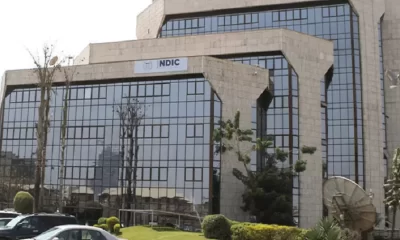Business
UBA: In a league of its own
Published
9 years agoon
By
Olu Emmanuel
Pan-African Banking Group, United Bank for Africa, UBA Plc has demonstrated extraordinary resilience in the face of macroeconomic headwinds mainly on the back of a well-diversified credit portfolio. ODUNEWU SEGUN writes
FULLY positioned as a pan-African bank, the United Bank for Africa Group is firmly in the forefront of driving the renaissance of the African economy and is well positioned as a one-stop financial services institution, with growing reputation as the face of banking on the continent.
Aside from being the first among international banks to be registered under Nigerian law in 1961, it was also the first to offer an IPO following its listing on the Nigerian Stock Exchange in 1970.
It was also the first Nigerian Bank to hit the NGN1 trillion balance sheet size, launched Nigeria’s First Cash Deposit ATMs, and also introduced the first visa dual debit card in Nigeria among other first initiatives that has revolutionized the banking system in Nigeria.
As at September, 30, 2015, the UBA Group with subsidiaries in 20 countries, representatives’ offices in France, UK and the United States, had a total assets of N2.873 trillion, customer’s deposits of n2.176 trillion, customer loans of N1.015 trillion and a total equity of N322.558 billion.
With a market capitalization of N123 billion as of January 4, 2016, and over 65 years of providing uninterrupted banking operations, UBA has carved a niche for itself in Nigeria’s banking sector.
UBA has demonstrated extraordinary resilience in the face of macroeconomic headwinds mainly on the back of a well-diversified credit portfolio. Increased exposure to other African markets has also provided some insulation from the headwinds in Nigeria, consequently, it has outperformed its peers in profitability and asset quality.
Return on average equity was 20.0 per cent in 2015 and 19.6 per cent in first quarter of 2016 which compares favourably to the 17.4 per cent and 17.8 per cent average reported over the same period within other banks operating in the country. UBA’s NPL ratio and Cost of Risk (1.7% and 0.4%) also sit better than peers (6.3% and 1.4%).
Today’s UBA emerged from the merger of then dynamic and fast growing Standard Trust Bank, incorporated in 1990 and UBA, one of the biggest and oldest banks in Nigeria. The merger was consummated on August 1, 2005, one of the biggest mergers done on the Nigerian Stock Exchange (NSE).
The quest to build a strong domestic and African brand intensified in 2008 when UBA made further acquisitions of two liquidated banks, Gulf Bank and Liberty Bank while at the same time intensifying its African footprint with the establishment of UBA Cameroon, UBA Cote d Ivoire, UBA Uganda, UBA Sierra Leone, and UBA Liberia as well as the acquisition of a 51% interest in Banque Internationale du Burkina Faso, which was the largest bank in the country with 40% market share. Currently, UBA has 18 African subsidiaries contributing about 20% of the Group’s balance sheet with a target of contributing 50%.
ALSO SEE: UBA stocks have potential to grow this year, says RenCap, CSL stockbrokers
On 13 December 2012, the shareholders of UBA Plc unanimously voted for the bank to restructure into a Monoline Commercial Banking Model in order for it to fully comply with the new CBN guidelines for commercial banks in Nigeria, which repealed the erstwhile universal banking regime.
With the restructuring, the Group’s non-commercial banking subsidiaries with the exception of Africa Prudential Registrars Plc and Afriland Properties Plc were consolidated under UBA Capital Plc and spun-off to shareholders of the Bank. The Bank’s excess real estate assets were used to capitalise Afriland Properties Plc, which was then spun-off, along with Africa Prudential Registrars Plc, to be held directly by the Bank’s shareholders.
Along with UBA Plc, the result of the restructuring is three stand-alone entities held directly by the Bank’s shareholders UBA Capital Plc and Africa Prudential Registrars Plc, which are already listed on the Nigerian Stock Exchange, as well as Afriland Properties Plc, now controlled by independent shareholders.
Under the Monoline business structure, UBA Plc remains the parent company for all of the Group’s commercial banking activities in Nigeria, Africa and the rest of the world. UBA Plc is also the parent company for UBA Pension Custodian Limited, UBA Capital (UK) and UBA FX Mart Limited.
Formed by the merger of the commercially focused UBA and the retail focused Standard Trust Bank in 2005, the Bank purports to have a clear ambition to be the dominant and leading financial services provider in Africa.
Since 2010 when the former Group Managing Director of the Bank, Philips Oduoza
took over the leadership of UBA, the bank has continued to grow in its gross earnings, assets, loans and deposits while maintaining unparalleled reputation for leadership, strength, and stability. Under him, the bank returned to profitability as the bank was able to reverse a loss position of N1.94 billion in 2010 when he took the saddle to making a profit of N48 billion in 2014.
ALSO SEE: GT Bank, UBA get thumps-up over impressive earnings, asset quality
But besides turning on profit, Oduoza impacted on the bank’s ability to do business as it saw a significant vault in total assets by more than a trillion naira or 72% in the last five years from N1.6 trillion in December 2010 to N2.8 trillion as at December 2014.
He also grew net operating income by 24% from N154 billion in 2010 to N192 billion in 2014.
The bank’s third quarter results for 2015 released last year shows that Oduoza will also be leaving the bank on a strong financial note. In the third quarter results released in October 2015 the bank recorded a strong 44% rise in profit after tax to N48.6 billion and a 17% rise in gross earnings to N247.2 billion.
UBA also closed the third quarter of 2015 with total assets of N2.87 trillion, loan book of N1.01 trillion and a deposit base of N2.18 trillion showing that Oduoza is leaving behind a strong performing financial institution to his successor.
Trending

 Politics6 days ago
Politics6 days agoPRP conducts ward, LG congresses in Lagos, elects new executives

 Business4 days ago
Business4 days agoControversy trails Dangote Refinery as stakeholders Allege systemic pushback against local investment

 News6 days ago
News6 days agoHeart of Gold Empowerment Outreach bolsters 30 indigent’s economic status in Edo State

 Business1 week ago
Business1 week agoNDIC begins liquidation of ASO Savings, Union Homes, moves to pay insured deposits

 Crime1 week ago
Crime1 week agoPolice To Resume Tinted Glass Enforcement

 Latest1 week ago
Latest1 week agoAkpabio denies health scare, dismisses reports of collapse on London trip

 Business4 days ago
Business4 days agoPresident Tinubu, Minister Wale Edun and Nigeria’s Fiscal Profile: The Truth and the Lies

 Business4 days ago
Business4 days agoSAGLEV clinches 2025 Nigeria EV Brand of the Year Award

